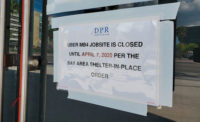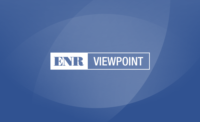Commentary: Channels of Communication
Viewpoint: How to Meet the Challenge of the New Normal in Post COVID-19 Reopenings

A construction worker wears a protective mask during the coronavirus pandemic as he unloads a truck standing in front of a sign reminding people to stay six feet apart in downtown Miami. Photo: AP Photo/Wilfredo Lee
The construction industry’s emphasis now is on safely returning employees and workers to offices and jobsites. In New York City alone, tens of thousands of construction workplaces were officially reopened on June 8. Plans are moving quickly and new protocols are being devised that include ultraviolet light for decontamination, modifying HVAC systems for better air filtration and implementing touchless technology. Strategies to provide safe working environments will likely feel strange at first to all staff, adding expense and ultimately affecting project costs and schedules.

A different kind of messaging is needed from what was used at the pandemic’s height, when the guidance from OSHA and the Centers for Disease Control and Prevention was evolving and local, state and federal guidance weren’t always in sync. Protocols like proper use of personal protective equipment and social distancing must still be communicated effectively to employees, owners, subcontractors and vendors—all key constituents. But without a robust plan, new workplace communication rollouts could be awkward. Without a good strategy, individuals responsible for making businesses run smoothly may be unable to convince workers to continue disciplined use of protective equipment and careful social distancing. Once that happens, other workers may become worried about their health and well-being. If procedures aren't followed and new technology not used as intended, the effort could be wasted. It may be necessary for leaders to work with industry partners while formulating plans that inspire more buy-in and help everyone involved. There’s a short window of opportunity to get all this right.
How do you create an effective program that engages stakeholders in the near term, and also over the longer term, until a coronavirus vaccine is in place?
Compassion can go a long way toward compliance.
If they haven’t already done so, companies of all sizes should consider putting together a COVID task force focused on communications, with department heads from disciplines including communications/public relations, human resources and operations. The task force should plan frequency of messages, content and delivery method. Daily emails are a good starting point to get the audience comfortable with receiving regular updates and to build trust.
Communicating with compassion is number one. Employees and other stakeholders can discern from the tone and content of the message whether the employer or industry partner is genuine. That compassion can go a long way toward compliance.
Senior leaders can be featured in weekly or twice-weekly videos or webinars, which will bring confidence to the troops.
DPR Construction developed a communications plan that included two weekly e-mails to employees (many of whom were and are working remotely) on COVID-related subjects and regular business matters from March to May, usually packaged with a weekly video.
Greg Haldeman, a member of the contractor’s management committee, said that DPR now sends out weekly emails, and firm leaders meet virtually on Tuesdays to discuss private information and relay appropriate facts to local employees.
Consider surveying employees at two-month intervals to learn how they are receiving messages and whether they have suggestions about communications or resources. They will let you know what’s working.
E-newsletters can explore specific topics in greater depth that are not appropriate for shorter e-mails. On-site and office signage can reinforce key messages.
Consider surveying employees at two-month intervals to learn how they are receiving messages and whether they have suggestions about communications or resources. They will let you know what’s working.
Elizabeth Brink, global workplace leader at Gensler, said the design firm looked to employees for input about their expectations for returning to the office. The company employed a survey communications tool that it also uses for clients. Gensler’s ongoing communication with employees and partners—which includes e-mails, team sites, webinars and Sharepoint sites—has allowed the firm to continue to operate at a high level.
To reduce burnout, innovative and fun ideas can be planned—and/or promotional items provided to constituents—that will keep up momentum and change the pace. For example, a company can order water bottles, mugs, frisbees or other promotional items that have the slogan, “We’re In This Together,” with the company logo printed on the gear.
Senior leaders should offer ways for employees to reach out to relay concerns or suggestions. And don’t underestimate the stress people are feeling these days from both work and family-related matters in these difficult times. Employees should be reminded about the company’s Employee Assistance Program and other mental health resources.
As with most matters that go to the heart of a company’s culture, the emphasis must start from the top.
Senior leaders should underscore that increased safety, precautions, social distancing, staggered work hours and more are the right thing to do. Separately, those same executives should have early conversations with owners, indicating that safety measures will result in increased project costs and schedules. It is a new way of doing business, not just to fend off trouble in the form of lawsuits or insurance claims, but because placing safety first is the right thing to do.
These are unparalleled times, and it will take unparalleled levels of communication to keep constituents informed about priorities and protocols. That’s how the business will move forward as effectively as possible.
Terry M. Kuflik, a communications and marketing professional for the construction industry, can be reached at tmkuflik@verizon.net.




